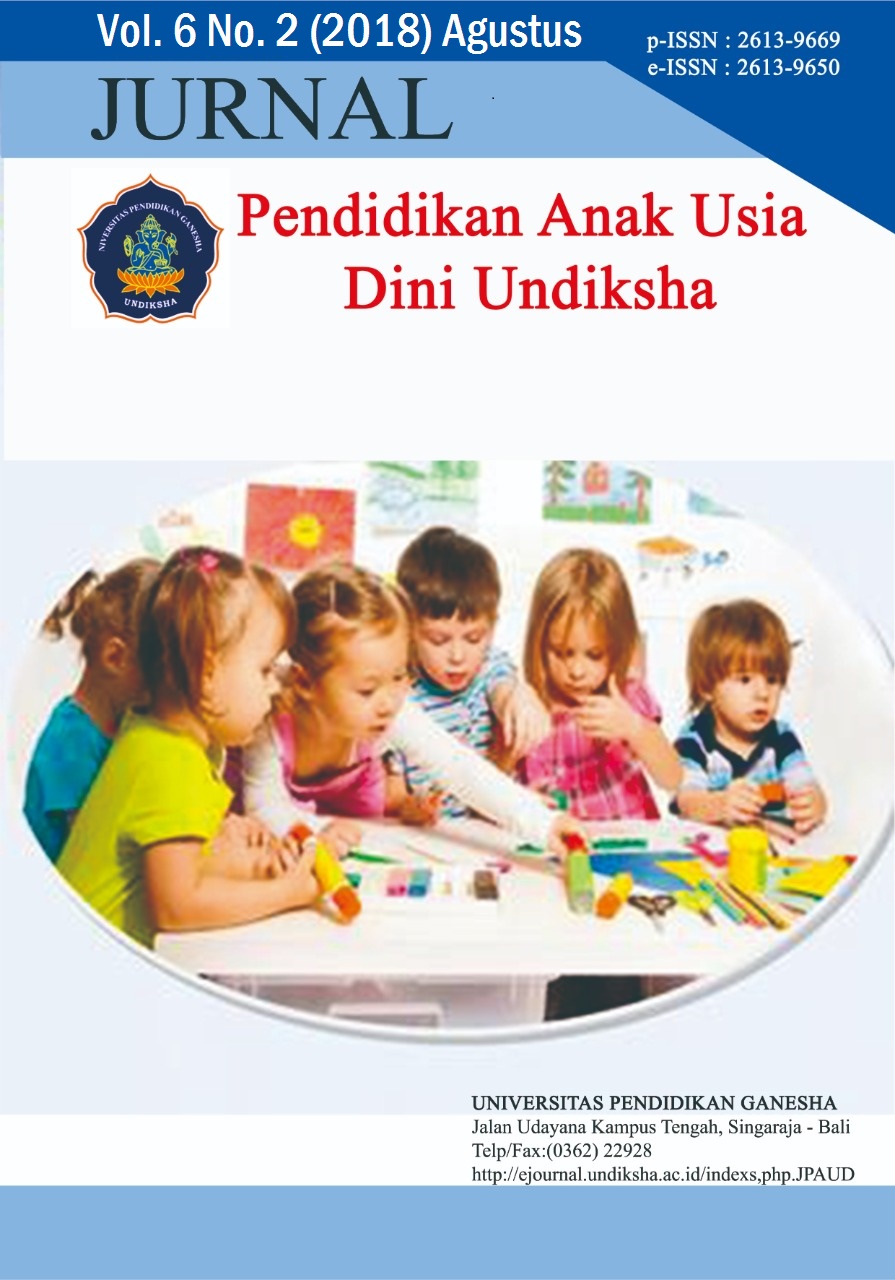PENGARUH TEKNIK CHAINING TERHADAP KEMAMPUAN TOILET TRAINING ANAK KELOMPOK BERMAIN GUGUS II KECAMATAN BULELENG TAHUN PELAJARAN 2017/2018
DOI:
https://doi.org/10.23887/paud.v6i2.15328Abstract
Penelitian ini bertujuan untuk mengetahui perbedaan yang signifikan kemampuan toilet training anak yang dibelajarkan dengan teknik chaining dibandingkan model pembeljaran konvensional pada Kelompok Bermain Gugus II Kecamatan Buleleng Tahun Pelajaran 2017/2018. Rancangan Penelitian ini adalah Quasi Eksperimen, dengan desain post-test only control group design. Sampel penelitian ini berjumlah 37 orang. Data hasil kemampuan toilet training dikumpulkan dengan menggunakan instrumen observasi. Penelitian ini menggunakan teknik analisis statistik deskriptif Anava Satu Jalur. Hasil penelitian menunjukkan bahwa terdapat perbedaan yang signifikan kemampuan toilet training anak yang dibelajarkan dengan teknik chaining dengan kelompok anak yang dibelajarkan dengan model konvensional. Perbedaan tersebut dilihat dari skor hasil kemampuan toilet training anak diperoleh hasil thitung 34,548 sedangkan ttabel sebesar 2,042 . Hasil perhitungan tersebut menunjukkan bahwa thitung lebih besar dari ttabel sebesar (34,548>2,042). Adanya perbedaan yang signifikan menunjukkan bahwa teknik chaining berpengaruh positif terhadap kemampuan toilet training anak kelompok bermain. Berdasarkan hasil penelitian ini disarankan teknik chaining dapat dipergunakan untuk memecahkan masalah dalam pengembangan kemampuan toilet training anak.Kata Kunci : Toilet Training, Chaining, Quasi eksperimen
The aim of this research is to know the significant difference of children toilet training ability which is learned by chaining technique compared to conventional learning model in Group Play Cluster II Buleleng Sub District Lesson Year 2017/2018. The design of this study was Quasi Eksperimen, with post-test design only control group design. The sample of this study amounted to 37 people. The observation results of toilet training ability was collected by using the observation instrument. This study uses descriptive statistical analysis techniques Anava One Path. The results showed that there were differences in the ability of toilet training of children who were taught by chaining techniques with groups of children who were taught by conventional models. The difference is seen from the score of children toilet training results obtained tcount 34.548 while the ttable of 2.042. The result of the calculation shows that tcount is bigger than ttable (34,548> 2,042). Significant differences indicate that chaining technique positively influences the ability of toilet training of playgroup children. Based on the results of this study can be suggested chaining techniques can be used to solve problems in the development of toilet training capabilities of children.
keyword : Toilet Training , chaining, Quasi Exsperiment
Published
2018-07-28
How to Cite
., L. S. A., ., D. P. A. A. S. M., & ., P. R. U. S. M. P. (2018). PENGARUH TEKNIK CHAINING TERHADAP KEMAMPUAN TOILET TRAINING ANAK KELOMPOK BERMAIN GUGUS II KECAMATAN BULELENG TAHUN PELAJARAN 2017/2018 . Jurnal Pendidikan Anak Usia Dini Undiksha, 6(2), 136–147. https://doi.org/10.23887/paud.v6i2.15328
Issue
Section
Articles
License
Authors who publish with the Jurnal Pendidikan Anak Usia Dini Undiksha agree to the following terms:
- Authors retain copyright and grant the journal the right of first publication with the work simultaneously licensed under a Creative Commons Attribution License (CC BY-SA 4.0) that allows others to share the work with an acknowledgment of the work's authorship and initial publication in this journal.
- Authors are able to enter into separate, additional contractual arrangements for the non-exclusive distribution of the journal's published version of the work (e.g., post it to an institutional repository or publish it in a book), with an acknowledgment of its initial publication in this journal.
- Authors are permitted and encouraged to post their work online (e.g., in institutional repositories or on their website) prior to and during the submission process, as it can lead to productive exchanges, as well as earlier and greater citation of published work. (See The Effect of Open Access)











